“Fear is a bad adviser. We make bad decisions when we’re afraid.” — Samantha Power, former foreign policy adviser to Barack Obama, speaking on the Charlie Rose Show about her book, “Chasing the Flame: Sergio Vieira de Mello and the Fight to Save the World,” sometime in mid to late February. Something for voters to consider, of course…but will they?
Day: March 7, 2008
“Jesse James” 2-Disc in England
Amazon.uk as well as DVD Active, another British site, are announcing a two-disc The Assassination of Jesse James by the Coward Robert Ford coming out on March 31st for 20 pounds (along with Blu-ray and HD-DVD editions plus a regular single-disc edition). No Warner Bros. publicists were around this afternoon to answer why this two-disc package hasn’t been offered to the American market.

The second disc offers a documentary, called “Death of An Outlaw,” that examines the life and death of the real Jesse James and also includes interviews with all the key cast and filmmakers. The package also offers a hard-back 44-page book about the film, the legend and the characters.
“Juno” frontlash, Hillary hate
A 3.7 Huffington Post article by Cinematical’s James Rocchi draws analogies between Juno backlash (or frontlash) and Hillary hate. As amusing and well-written as the piece is, it would feel slightly more vital if it had come out before the Oscars, or when the Juno backlash was really strong in late January to early February. I think most of us feel Juno-ed out at this stage.
Chait’s “Go Already!”
Jonathan Chait‘s 3.6.08 New Republic piece, “Go Already! — Hillary Clinton, fratricidal maniac” — begins with a reasonable judgment that “Clinton’s path to the nomination is pretty repulsive. She isn’t going to win at the polls. Barack Obama has a lead of 144 pledged delegates. That may not sound like a lot in a 4,000-delegate race, but it is. Clinton’s Ohio win reduced that total by only nine. She would need 15 more Ohios to pull even with Obama. She isn’t going to do much to dent, let alone eliminate, his lead.
“That means, as we all have grown tired of hearing, that she would need to win with superdelegates. But, with most superdelegates already committed, Clinton would need to capture the remaining ones by a margin of better than two to one. And superdelegates are going to be extremely reluctant to overturn an elected delegate lead the size of Obama’s. The only way to lessen that reluctance would be to destroy Obama’s general election viability, so that superdelegates had no choice but to hand the nomination to her. Hence her flurry of attacks, her oddly qualified response as to whether Obama is a Muslim (‘not as far as I know’), her repeated suggestions that John McCain is more qualified.”
Barack Obama = Grace Kelly
The situation facing Barack Obama right now is not dissimilar to the one facing Grace Kelly‘s character, Amy, in High Noon (1952). As everyone knows the Illinois Senator has been a proponent, in a manner of speaking, of non-violent campaigning. But the clock has struck twelve, the train has arrived and the Clinton gang, clearly committed to the low and the dirty, is making its way down Main Street and looking to fill him with hot lead. In such a situation, can a pacifist stay a pacifist?
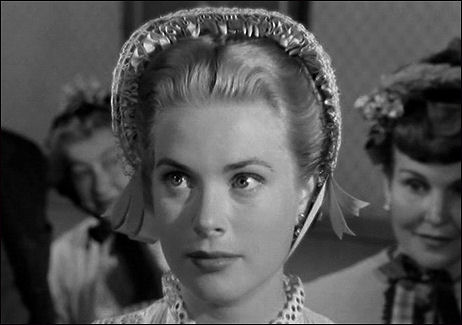
Just as Amy makes it clear early on to Gary Cooper‘s Will Kane that she despises violence and won’t abide it, even if it means not supporting Kane’s decision to stand up to the Frank Miller gang, Obama has said he won’t engage in the old political battle language and reflexes of the past. He believes, correctly, he has to be the guy with a new way, a new hymnbook. He can’t just be another tit-for-tatter looking to get elected. If he succumbs and plays the same old game, Obama believes, he’ll be sacrificing an essential part of his appeal.
Not so. Not at this stage of the game. Obama can’t be anyone other than himself — he’s nothing if not comfortable in his own skin — but he has to find a way to stand up, strap on the leg irons and be the tough guy as well as the good guy. The tough challenges that are sure to confront the next president in the domestic and foreign arenas are in some ways analogous to the tough challenges in a political campaign. Question is, will the big cathartic moment of High Noon, which belongs entirely to Amy, work in a real-life political context?
The big High Noon “turn” happens when Kelly hears shots fired and suddenly becomes combative. She shakes off her philosophical reservations and reacts instinctively. About to leave town on the same train, she jumps off and runs into town to help her husband. A few minutes later she does a shocking and cathartic thing by shooting bad guy Robert Wilke as he’s re-loading his six-shooter. In the back even! And it’s a great moment!

If you’ve ever seen High Noon with an audience (as I have), you know people go batshit when this happens. Somebody involved with the film (director Fred Zinneman, screenwriter Carl Foreman, producer Stanley Kramer) is quoted on the DVD as saying they knew High Noon would be a hit when they heard a test audience cheer this moment.
People understand the way things are. We all agree with non-violence and positivism and constructive behavior as long as the Frank Miller gang isn’t threatening to do harm. When sociopaths push their way into the situation, things change. Sometimes you have to stand up and tell the bullies to surrender their weapons or else. People understand this. They sure as hell don’t respect a man who avoids a fight because he doesn’t believe in fighting. That’s out.
By the way: yesterday I suggested an analogy between older white women who are standing by Hillary Clinton despite her general monstrousness and the “downtown” jury that found O.J. Simpson not guilty in his 1994 murder trial despite the facts presented by the prosecution. The point was that loyalty is blind. Anyone who knows what loyalty is knows the truth of this.
Burrows’ melancholic beauty
In her review of Roger Donaldson‘s The Bank Job, N.Y. Times critic Manohla Dargis has written a flattering graph about costar Saffron Burrows, describing her “Martine” character as “a pulpy femme fatale who’s been sensitively shaded.”

Safron Burrows
Noting her modelling background, Dargis describes Burrows as an “angular, melancholic beauty [who], after making the usual independent rounds — Mike Figgis directed her in his screen adaptation of the Strindberg play Miss Julie — [has] slowly and somewhat unexpectedly emerged as an actress to watch.
“Sadness clings to Ms. Burrows: it hoods her eyes, tugs at her mouth and wraps around her like a gossamer shawl. It gives her mystery and, like the hints of age edging her face, blunts the impact of her beauty, making her character more human and emotionally accessible than she might register otherwise.” Nicely put.
Downey’s “Thunder” pigmentation
Responding to Robert Downey‘s upcoming portrayal in Ben Stiller‘s Tropic Thunder (DreamWorks, 8.15) of an Oscar-winning actor who gets a massive makeover in order to play an African American character in a war film, a complete boob posted the following yesterday on Just Jared: “I’m not black and I find it offensive. Are there not any talented enough black actors out in the world that they feel the need to hire a white guy to do a black guy?”
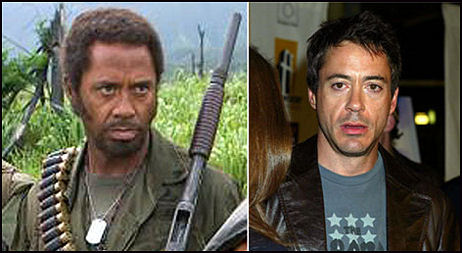
There’s no limit when it comes to the human capacity for massive cluelessness and stupidity. Where there’s a will, there’s a way.
Tropic Thunder is “about five actors who go on location and find themselves, through a series of freak occurrences, relying on their boot camp experiences when they get stuck in a real war-like situation,” etc.

Tropic Thunder costars Jack, Black, Downey, Ben Stiller
Downey has been quoted by Entertainment Weekly that if the performance is “done right, it could be the type of role you called Peter Sellers to do 35 years ago. If you don’t do it right, we’re going to hell.”
I think this aspect of Tropic Thunder is one of the funniest ideas to come along in this vein since James Whitmore starred in Black Like Me (1964). The other films in this vein are the much less entertaining Watermelon Man, with Godfrey Cambridge (’70), and Soul Man (’86) with C. Thomas Howell.
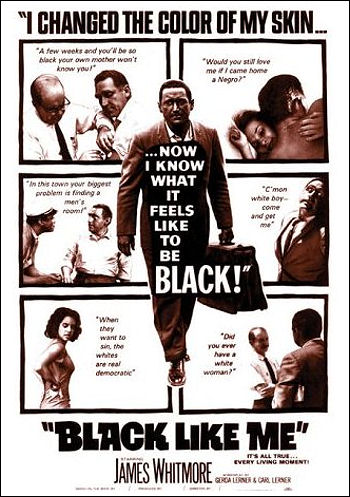
Warner Independent on the ropes?
Two portions of yesterday’s Anne Thompson 3.6 Variety column about the legacy of Bob Shaye and New Line Cinema caught my attention. One is a statement that Bob Berney‘s Picturehouse “is likely to merge with the floundering Warner Independent Pictures,” which seems to confirm suspicions that Warner Independent may be done as a stand-alone unit. (I’ve made calls about this, etc.) The other is her observation that “there was always an aura of the dysfunctional family around New Line.” I wrote about this very aspect a few days ago in my own looking-back-at-New Line article.
“Color Purple” trauma
There are plans afoot to make a movie based on the Color Purple musical on Broadway that closed two months ago, starring Fantasia Barrino. I never saw it but I probably would have refused an offer of free tickets. This is no reflection on the show (which was said to be quite good), but recollections of Steven Spielberg‘s film of the same name.
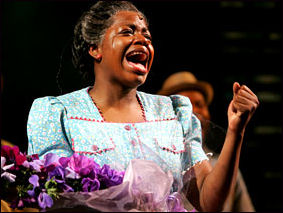
Fantasia Barrino
Exceptional trauma burns into one’s consciousness and remains like a scar. I saw this Oscar-nominated fiasco in a Burbank screening room 23 years ago, and it’s like it happened yesterday.
We all go into films with our mollecular constitutions intact, but the chemistry changes if the film has a spiritual current of any force. We begin to feel more awake, alive, aroused if the film is on the right track, and we start to feel more and more depleted and nauseous if it’s not. The gross theatricality of The Color Purple made me feel as if the oxygen levels in the screening room were being slowly emptied.
I came out numb and staggering. It caused me to completely reevaluate Spielberg, whose films I had mostly admired and even worshipped up to that point. In my head the name “Spielberg” became permanently damaged after this. I came out of it despising Whoopi Goldberg, Danny Glover, Oprah Winfrey…everyone in the cast. Composer Quincy Jones, producers Kathy Kennedy and Frank Marshall…everyone came out tainted.
No, I’m not going to explain my reservations in detail. I only know that I’ve never felt so smothered and assaulted by a sense of falseness and auteurist pretense in my entire moviegoing life.

When I was three or four I somehow became terrified of a big color illustration of a badger in a children’s book. I was so fearful of this image this that my parents promised to throw the book into the garbage in order to calm me down. (I later learned that they only hid it in the bottom of a bureau drawer.) The Color Purple became the near-equivalent of that badger in my adult life.
Noonan on Clinton (cont’d)
From Peggy Noonan‘s latest (3.7) “Declarations” column in the Wall Street Journal: “What do I think is the biggest reason Mrs. Clinton came back? She kept her own spirits up to the point of denial and worked it, hard, every day. She is hardy, resilient, tough. She is a train on a track, an Iron Horse. But we must not become carried away with generosity.
“The very qualities that impress us are the qualities that will make her a painful president. She does not care what you think, she will have what she wants, she will not do the feints, pivots and backoffs that presidents must. She is neither nimble nor agile, and she knows best. She will wear a great nation down.”
In a recent Elle magazine interview, Natalie Portman dismissed much of what offends the Hillary haters as “sexist.” What is her response, I wonder, to what Noonan and Maureen Dowd have been writing all along about Clinton?
Noonan ends her column with a ghastly quote from Christopher Hitchens spoken during an interview with Hugh Hewitt, to wit: Hillary will eb the next president because “there’s something horrible and undefeatable about people who have no life except the worship of power…people who don’t want the meeting to end, the people who just are unstoppable, who only have one focus, no humanity, no character, nothing but the worship of money and power. They win in the end.”
For saying it plain
Samantha Power, described as a “key foreign policy aide’ to Barack Obama, told The Scotsman that Clinton “is a monster….she is stooping to anything. You just look at her and think, ‘Ergh’. But if you are poor and she is telling you some story about how Obama is going to take your job away, maybe it will be more effective. The amount of deceit she has put forward is really unattractive.”

Power was forced to resign for understandable reasons. One of the most fundamental rules of public relations is that you can’t bluntly say what almost everyone believes deep down. In my book she’s a truth-speaker likeRobert Ryan‘s John the Baptist in King of Kings. King Herod ordered his head cut off for pointing at Brigid Bazlen‘s Salome and calling her a “daughter of abomination,” but John was at one with God’s heart. I am standing (well, sitting) here and telling, as God is my witness, the truth, which is that Power (a) should have been more careful but (b) she said it straight and true.
Elizondo at the Aero
The spirited Hector Elizondo did a q & a following last night’s Aero screening of Joseph Sargent‘s The Taking of Pelham 123. Elizondo plays the coarse, dryly menacing “Mr. Gray,” one of four disguised men who hijack a subway train in this 1974 classic. I didn’t know Elizondo would be visiting until I arrived, but it was a real pleasure to absorb his humor and energy and rascally wit.
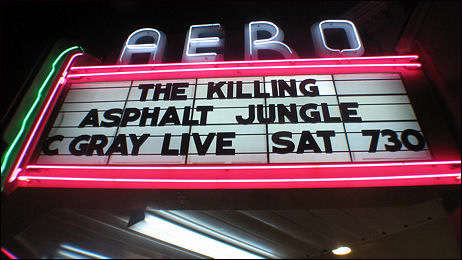
Born in 1936 and raised in southwest Harlem, Elizondo gives off a kind of sophisticated street schwing that feels highly infectious. His basic attitude is a combination of “what’s next?,” “keep moving,” “look deeper” and “never stop with the jokes.” You can take the man out of Manhattan (I presume Elizondo lives out here) but you can’t the Manhattan out of the man. I didn’t take his picture but I applauded with vigor when the interview ended.
The Taking of Pelham 123 looked great — no scratches or color deterioration, although the sound felt weak. Charley Varrick, which went on at 10 pm after Elizondo signed off, came from a very clean and well-tended print, but the images seemed too dark at times. The DVD delivers more visual value. Too many scenes last night seemed underlit in a way that couldn’t have been intended by director Don Siegel.

